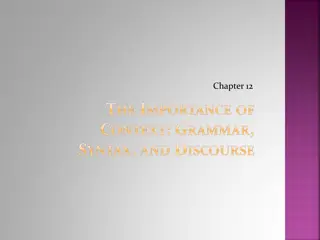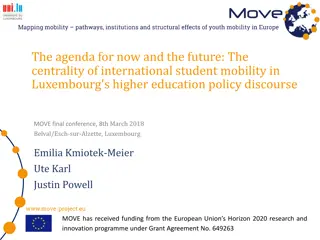Promoting Integration Through Public Discourse: International Conference Insights
Public discourse plays a crucial role in shaping societal perceptions of diversity and integration. The Integration Foundation International Conference delved into communicative practices that both promote and hinder integration, emphasizing the responsibility of public communicators in constructing narratives of diversity. The event aimed to offer recommendations for fostering inclusive discourse, identifying discriminatory practices, and advocating against them. Drawing on interdisciplinary foundations, the conference highlighted the importance of understanding and combating subtle discriminatory discursive constructions in promoting integration.
Download Presentation

Please find below an Image/Link to download the presentation.
The content on the website is provided AS IS for your information and personal use only. It may not be sold, licensed, or shared on other websites without obtaining consent from the author. Download presentation by click this link. If you encounter any issues during the download, it is possible that the publisher has removed the file from their server.
E N D
Presentation Transcript
Promoting integration through public discourse Integration Foundation International Conference Communicating in a diverse society: hearing each other despite differences 12thNovember, 2020 Gema Rubio Carbonero Serra H nter lecturer-Department of Translating, Interpreting and East Asian Studies Universitat Aut noma de Barcelona
Main points of the talk Communicative practices that promote integration Communicative practices that hinder integration Do, detect and condemn
Introduction- General assumptions Public discourse plays a key role as a creator of opinions and attitudes in society towards particular realities. ? So, how our public communicators (media, politicians) represent diversity will have an impact on how society understands and interprets and assesses diversity. ? Public discourse can shape opinions and attitudes about migrants. ? Public discourse does not only influence at the cognitive level, since attitudes and opinions shape at the micro level the interaction between autochthonous and migrants. ? This is why those that have the power to produce and distribute public discourse have a great social responsibility on the way they construct diversity through discourse. ?
Goals ? To offer a framework of general recommendations of the characteristics public discourse should have in order to promote integration ? To reflect on some subtle discriminatory discursive practices common in public discourse that hinder integration ? To offer the tools to enable the detection of subtle discriminatory discursive practices and encourage a condemning stance towards them.
The interdisciplinary foundations of the framework The good practices: Council of Europe (The intercultural city Step by Step, 2019)? discourse should be like in order to promote those values that can ease the path for integration (Rubio-Carbonero and Van Dijk, 2015) how ? The reflection on the (subtle) discriminatory discursive construction is based on my own research (Rubio-Carbonero, 2020) that is inspired by the studies of the conceptualization of racism and discrimination in three different disciplines: ? ? Political sociology (Triandafyllidou, 2013; Fekete, 2009; Fenton, 2010; Bauman 2004) ? Social psychology (Allport, 1977; Pettigrew and Meertens, 1995; Esses et al. 2001, 2008; Moscovici, 2001; Goffman,1974; Feldman, 2007) ? Critical Discourse Studies (Reisigl and Wodak 2009; Rubio-Carbonero and Zapata Barrero, 2017;Van Dijk, 2003; Wodak and Van Dijk, 2000)
A general framework based on values to promote integration through public discourse 1/2 Addressed to the whole population Cohesion Focused on those characteristics that make people unite Equality Encourage tolerance and respect towards everyone and promote the idea of pluricultural citizenry Tolerance Represent diversity as heterogeneous, dynamic and plural Diversity Hybrid cultural identities Multiculturality
A general framework based on values to promote integration through public discourse 2/2 Promote the positive aspects of diversity Opportunity Encourage mutual understanding Interaction Show the reality of immigration and the opportunities Empathy Integration as a process of accommodation that affects everyone Accommodation Transparency Transparent and rigorous when describing diversity
Subtle discriminatory public discourse 1. Highlighting Difference Threat Burden Ingroup s identity 2. Diminishing or omitting Similarities Ingroup s negative aspects Migrants/Ethnic minorities as recipients of discourse 3. Homogenizing and degrading Generics Dehumanizing terms 4. Normalizing Presuppositions Associations Metaphors
Highlighting ? Difference: focusing on those aspects that make people in society different by either: ? Setting other cultures are distant cultures ? Making unequal comparisons ? By providing irrelevant information ? Threat: constructing immigration as a threat ? Burden: Constructing immigration as a burden ? Ingroup s culture, identity, nation and values: Ex. 1: From Esquerra we would like to show and prove that there is another model of integration, of social cohesion, that there is a model of interculturality, based on the respect, in the first place, to the host society, offering the tools to get to know our country, our history, our culture and our reality as a nation. (Electoral program, ERC, 2010)
Diminishing or omitting ? The ingroup s negative aspects: Nominalizations and passivizations. Compare these sentences: ? The police shot balls at immigrants from Morocco in the sea. Balls were shot at immigrants from Morocco in the sea. ? ? The similarities different nations, cultures or religions share. ? Immigrants as recipients on discourse: Ex. 2: We must be an open society and also open to immigration, but as long as this (immigration) respect the laws of our country and has the will to accept some minimal commitments with our values and our lifestyle. (Plenary session, Mili n Querol (PPC), 14th, March, 2012)
Homogenizing and degrading ? Generics: when a concrete conflictive situation is presented as being typical and representative of the whole attitude or behavior of a particular social group. ? Dehumanizing terms to refer to ethnic minorities (such as illegal, criminals, dirty, ugly, dangerous, violent, freeloaders, liars, etc.) invite the audience to avoid empathy towards them.
Normalizing ? Presuppositions are propositions that are not stated in discourse but they are presented as already known and can be traced through discourse and contexts: EX. 3: Does a municipality where there is immigration have the same problems as one that does not have immigration? Logically, no. (Plenary Session, Renom i Vallbona (CiU), 6th, February, 2008) ? Associations: ideas that are continuously and repeatedly juxtaposed will produce an inseparable association ? Metaphors related to the conceptualization of the arrival of immigrants as natural disasters (waves, avalanches, tsunamis) and of the hosting country as a home Threatening vs. Defensive stance
Do, detect and condemn It is a first systematic approach to make explicit recurrent subtle discriminatory constructions appearing in public discourse when talking about diversity. ? It suggests 10 recommendations for constructing a public discourse that can promote integration. Obviously in politics, such discourse should be accompanied by policies and measures in accordance with the discourse. ? It offers a tool that can help society to easily identify those subtle constructions of discriminatory public discourse. ? Such a detection is the first necessary step to later be able to condemn discriminatory public discourse. ? A condemning stance towards (overt or subtle) discriminatory constructions in discourse is necessary to avoid the normalization of discrimination in public discourse and in society. ?
References Allport, Gordon Willard. 1977. La Naturaleza del Prejuicio. Buenos Aires: Editorial universitaria de Buenos Aires. Bauman, Z. (2004). Identity. Cambridge: Polity Press. Council of Europe (2019) The Intercultural City Step by Step. A practical guide for applying the urban model of intercultural inclusion. ? ? ? ? Esses, V. M., J: F. Dovidio, L: M. Jackson, and T. L. Armstrong (2001). The Immigration Dilemma: The Role of Perceived Group Competition, Ethnic Prejudice, and National Identity. Journal of Social Issues 57: 389 412. ? Esses, V. M., S. Veenvliet, G. Hodson and L. Mihic (2008). Justice, Morality, and the Dehumanization of Refugees . Social Justice Research, 21, 4 25. ? Fekete, L. (2009). A suitable enemy: Racism, Migration and Islamophobia in Europe. London & NY: Pluto Press. ? Feldman, J. (2007). Framing the Debate: Famous Presidential Speeches and How Progressives Can Use Them to Control the Conversation (and Win Elections). Brooklyn, NY: IG Publishing. ? Goffman, E. (1974). Frame Analysis. Harvard: Harvard University Press ? Moscovici, S. (2001). Social Representations. Explorations in Social Psychology. New York: New York University Press, ? Pettigrew, T. F., and R. W. Meertens. (1995). Subtle and Blatant Prejudice in Western Europe. European Journal of Social Psychology 25: 57 75. https://doi.org/10.1002/ejsp.2420250106 ? Reisigl, Martin, and Ruth Wodak.( 2005). Discourse and Discrimination: Rhetorics of Racism and Antisemitism. London New York: Routledge. https://doi.org/10.4324/9780203993712 ? Rubio-Carbonero, G. (2020). Subtle discriminatory political discourse on immigration. Journal of Language and Politics. https://doi.org/10.1075/jlp.19069. ? Rubio-Carbonero, G., and R. Zapata-Barrero. (2017). Monitoring Discriminatory Political Discourse on Immigration: A Pilot Study in Catalonia. Discourse & Society 28, 204 25. ? Rubio Carbonero, G., Van Dijk, T. A. (2015). Marco discursivo. Hacia la construcci n de un discurso anti-racista. In Zapata-Barrero, R., Guidokova, I. (Eds.). Las condiciones de la interculturalidad: gesti n local de la diversidad de Espa a. Valencia: Tirant lo Blanc (111- 136). ? Triandafyllidou, A. (2013). National Identity and Diversity: Towards Plural Nationalism. Edited by Jan Dobbernack and Tariq Modood. Tolerance Intolerance and Respect Hard to Accept. London: Palgrave Macmillan. ? Van Dijk, T. A. (2003). Racismo y Discurso de las lites. Barcelona: Gedisa. ? Wodak, R., & Van Dijk, T.A. (2000). Racism at the Top. Parliamentary Discourses on Ethnic Issues in six European States. Austria: Drava.
Thank you for your attention Gema.rubio@uab.cat























